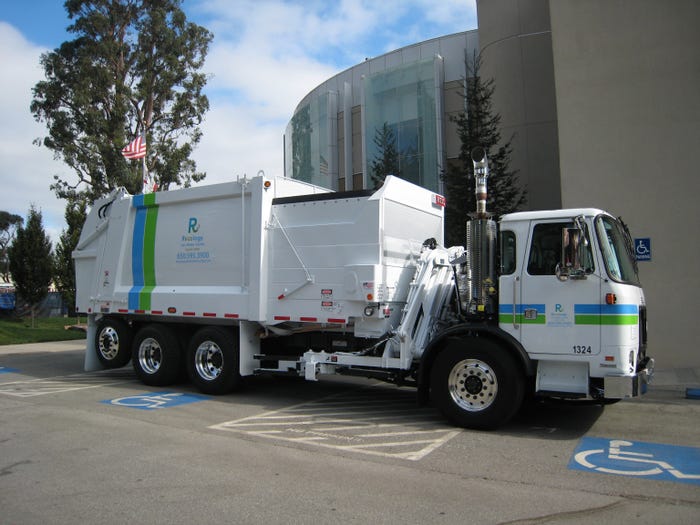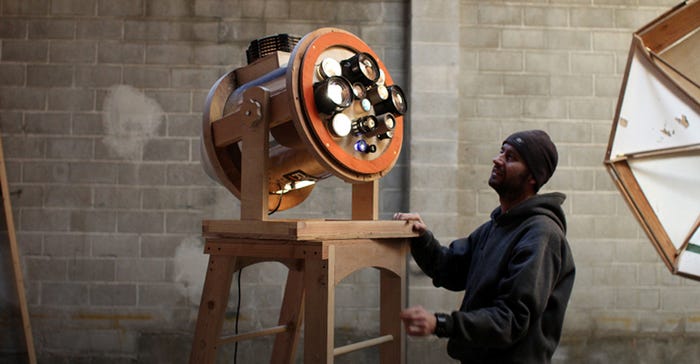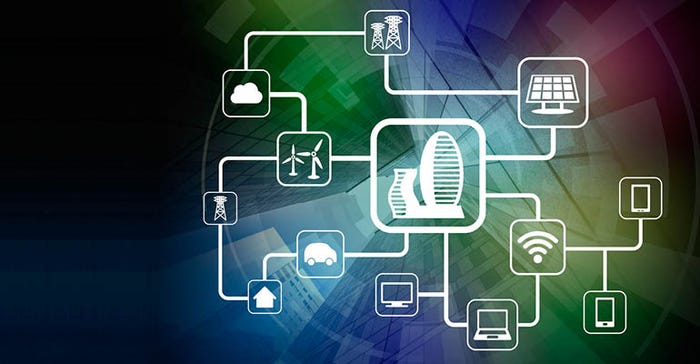A Conversation with Recology President and CEO Mike Sangiacomo
Waste360 talked with Sangiacomo about how Recology is helping the city of San Francisco reach its zero waste goals and the challenges he’s faced throughout his career.

For years, San Francisco-based Recology has worked to identify the needs of the communities it serves in the states of California, Oregon and Washington, develop and implement programs to collect and process materials, design effective sorting strategies, establish successful outreach and education programs, build infrastructure to extract and sort raw materials and ensure that recycled commodities are sold to manufacturers to create recyclable consumer goods.
It's part of the company's mission to create a world without waste by developing and discovering sustainable resource recovery practices.
Leading the company on its zero waste journey is CEO and President Mike Sangiacomo, who believes that in order to achieve zero waste people have to use resources wisely, generate waste only as necessary and find new and innovative ways to use waste products in ways that benefit our environment.
Waste360 talked with Sangiacomo about how Recology is helping the city of San Francisco reach its zero waste goals, the challenges he’s faced throughout his career and his biggest mentors who have helped shape him into the person he is today.
Waste360: Before you became CEO and president of Recology, you served as the CFO at Sunset Scavenger’s parent company. Tell us about that experience.
Mike Sangiacomo: I am the son of a San Francisco garbage man and Italian immigrant. Growing up, I had the most wonderful experience going to work with him in Chinatown. When I was 16, I went home and told my father that I wanted to go to college. I actually ended up serving in the military for some time, and then I got into the practice of public accounting. I did that for about seven years, and then I joined a company in the rice milling and grain trading business as a public controller. I eventually moved up to CFO, and then I became the CFO of Sunset Scavenger (a subsidiary of Envirocal), which was one of the two waste companies based in San Francisco at the time.
As CFO, I saw the need to modernize a lot of things being done back then. About three years into my career there, Sunset Scavenger merged with Norcal Waste Systems, which was the parent company of the other waste company based in San Francisco. After that happened, I was asked to be the general manager. In that role, I helped the company start a curbside recycling program in San Francisco along with a handful of other things.

In August 1988, I was asked to be the CFO of the company, and I spent a couple of years trying to help the company grow. After about two years, the CEO of the company was asked to step aside, and I was appointed to acting president and CEO, which later became my actual role in January 1991 when we defaulted on all of our debt.
In 2009, the company changed its name to Recology to demonstrate that we weren’t just about picking up garbage and putting it in the landfill. We wanted a name that reflected that we were doing things that we thought were beneficial for the environment, and we wanted to be known as a company focused on recycling and waste diversion rather than a pure waste company.
Waste360: Since becoming CEO and president of Recology, what challenges have you faced and how did you overcome those challenges?
Mike Sangiacomo: The first set of problems that I faced was the financial default, which took us a couple of years to straighten out because we had to get some litigation settled and some leaders comfortable with that we were doing.
We had a major refinance in the latter part of 1995, and once we did that, we were able to create a company that could sustain itself. We redid the way the company was run and started doing a few new and exciting things such as helping the city of San Francisco achieve its 50 percent waste diversion goal by building some new facilities there for single stream recycling and construction and demolition recycling.

We also piloted and launched the first organics waste recycling business and composting operation, and we switched the city over to a three-cart collection system to make separating materials easier for residents. That effort took about three years, and while success started off slow, the pace picked up over time.
Over the last 10 years or so, we have done a fair amount of business development and grown the business in more communities within three western states. That has been a challenge, but we are learning and continuing to grow as we expand.
Waste360: San Francisco recently committed to making the switch to 16-gallon refuse carts. What are some of the benefits of that?
Mike Sangiacomo: The city wants to send zero waste to landfill, and we are trying to help them accomplish the goals that they have set up for us. We go through rate processes with them every now and then and that tells us what we can charge for the services that we provide and what the city wants to accomplish during the time when the rates are effective.
Recently, the city asked us to downsize all of the black trash carts to 16-gallon carts and to double the size of the blue recycling carts to 64 gallons. This change is voluntary, and we understand that not everyone is able to make the change so there is an opt-out option. That being said, this change will encourage residents to recycle more materials and to be more mindful about what they are throwing out.

We are trying to be very aggressive at pushing the envelope on what can be recycled and at finding partners that can use those commodities. The National Sword policy and what’s going on in China is having some effect on us and how we move products, but I think that will probably be a temporary thing. We have been known to generate a high-quality, recycled commodity, and when there are markets available, we will continue to do that.
Waste360: Safety is an ongoing issue in the industry. What are some of the measures Recology uses to ensure safety for both its customers and employees?
Mike Sangiacomo: We have installed drive cams in about two-thirds of our trucks, and we are conducting regular reviews with our drivers to discuss the unsafe actions they are taking on a daily basis. We hold monthly safety meetings to go over any safety issues and to constantly educate our drivers on proper safety measures because people are more distracted than ever these days. It’s important to remind our drivers that safety is something that needs to be done every day.
Recently, we developed a new safety signage program, which promotes the messages “Be safe today” and “You matter the most to us.” In addition to that, we are testing a couple of different technologies like sensors that send warning notices to drivers when they are getting to close to something. In 2018, we will make a decision on which technologies to use in our operations.
Waste360: Tell us about Recology’s Artist in Residence program and how that has grown over the years.
Mike Sangiacomo: We have a committee made up of local artists and people who are interested and knowledgeable about the arts that makes the selection of six residents each year. Every year, six artists and one student artist are chosen to participate in the program.
We started the program in San Francisco in 1990. Since then, we have launched similar programs in Portland, Ore.; Astoria, Ore.; and Seattle. All of them are a little different based on community requests and facility access, but we ultimately provide them with access to public disposal areas and a variety of materials so they can make art out of recycled materials.
We are currently talking with the city of Davis about a contract and possibly starting an art program there, which is very exciting for us. The residence program is not our main focus, but it does make people aware of materials that could potentially have new value and new life to it.

Waste360: Last year, Recology upgraded Recycle Central to increase its recycling capacity. Tell us a little bit about that.
Mike Sangiacomo: The line we put in Recycle Central was built in 2002, when the recycling center opened. We designed that line ourselves, and at the time, nothing like that line had ever existed before. Since then, companies like Machinex, Bulk Handling Systems and VAN DYK Recycling Solutions have built new systems that are more flexible and capable of talking to each other. We knew it was time to upgrade, and we put in a new line that’s capable of doing a lot more than we were able to do previously. With the new line, we can now handle a greater variety of products and separates them more easily.
Waste360: What are some of the goals that Recology and its employees are currently working toward?
Mike Sangiacomo: Our fiscal year just ended, and we surpassed the billion dollar mark, which was a long time and coming but something we are very excited about. Now, we are working diligently to close a transaction on a business that’s primarily in Sonoma County, and we are in the stage where we are asking 14 municipalities to approve the assignment of the contracts. Some are complete and most are scheduled, but the fires in Sonoma County have delayed the process a bit.
For the next fiscal year, we are looking for other places to grow and offer our services. We are also focusing on our safety programs and on our opportunities to diver more material from landfill. Right now, we are too reliant on China for markets, and we want to see what other options are out there for moving our materials and increasing the amount of material that we move.
Waste360: Technology is changing the industry at a rapid pace. How is Recology utilizing technology to better improve operations?
Mike Sangiacomo: Being in California, we talk to people who are working on new technologies all the time, and we have an innovation lab where we can test certain technologies out. A lot of these technologies are in their early stages, and we’re keeping tabs of what’s of interest to us and the industry as a whole.
I think there will be a lot of changes in the future, and we are working to continually adapt and use the new technologies that are valuable to us.

Waste360: Who are your biggest mentors and how have they helped shape you to become the person you are today?
Mike Sangiacomo: I learned a lot from my maternal grandmother. When I was about 8 years old, paper towels were just invented, and my mother brought a roll over to my grandmother’s house. My mother explained to my grandmother what paper towels were, and my grandmother started using them to wash and dry the dinner dishes. When we went to leave my grandmother’s house, she started hanging up the paper towels just like she would a dish towel. My mother told her that paper towels are meant to be thrown away after they are used, and my grandmother looked at her and said, “That’s stupid.” That statement always stuck with me, and I agree with her. While trying to make life easier, we have become such a wasteful society. I have made it a goal of mine to try and minimize what I end up throwing away, and I hope I have put that mindset into Recology.
John Molinari, retired court of appeals justice whose father was one of the founding shareholders of Golden Gate Disposal, is also a mentor of mine. He is a wonderful man who knows a lot about the industry and how to deal with complex issues. Over the years, he has become a good friend, and he has taught me a lot both in terms of business approach and ethics.
I also learned a lot from a guy named Curt Rocca. I worked for him when I left public accounting, and he is a man who is highly imaginative and knows how to come up with interesting solutions to a lot of difficult problems. For example, he developed a lock system at the Port of Inchon in South Korea to keep the inner harbor at a content level so that ships could be loaded and unloaded in a safe and timely manner. He also got the Word Bank to finance the development of a grain terminal about a mile away from the port so that the grains could be easily transported on a conveyor belt and protected until they were ready to be used to generate food products.
Waste360: What advice would you give to someone who is considering joining the waste and recycling industry?
Mike Sangiacomo: This industry is a lot of fun, and there’s still plenty of room in this business to be creative about the way materials are handled. If you get in with the right company and are able to have an influence on the way the business is operated than it’s an extremely rewarding and exciting career.
For me, the industry has been very rewarding. I have also seen the way this industry can change other people’s lives for the better. For example, when we built Recycling Central, we voluntarily agreed to offer jobs to folks who reside in that area. We interviewed about 800 people and ended up hiring about 200 people. It wasn’t for everybody, but the ones who stuck it out are now starting to buy homes, send their kids to college and pay off some of their debt.
The only way that we are going to change our society and our unemployment problem is by giving people an opportunity.
About the Author
You May Also Like




